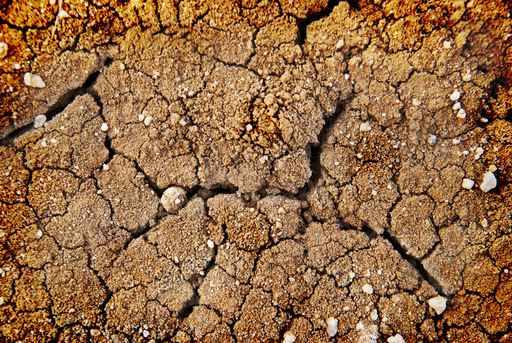I have experiments happening all over the yard. A hugel bed, composting in place, layers of wood chips - I am trying it all. Now I am trying to decide how to proceed in the worst area of the yard. There were several inches of decomposed granite spread over the center of the yard, upon which the previous owners had a batting cage.
Prior to that I have learned they used to ride dirt bikes around the yard. Basically when we bought the place last year there were only some trees on the edges of the property. I have been doing some experiments and while kitchen stuff is composting on top, not much is going down. Test plants that usually grow like crazy are staying alive but the roots aren't going down, mostly sideways under the mulch.
So now I wonder before I do another chunk of piling organic matter to build soil, if I should go ahead and break up the top layer an inch or two? I want to be a no-till garden but I think this tough dead zone might need some help at first. Amending the soil with organic matter naturally helps to break up tight clay soils over the long term. The particles in the organic matter physically separate the clay particles in the soil that cause the soil to be tight. Organic matter in the soil also encourages earthworms to move in.
As earthworms move through the soil, eat organic matter and excrete castings, they help to aerate and loosen the soil. Their castings also are rich in nutrients that are more readily available to plants than the nutrients from the soil. Compost should be used for the organic matter, and other soil amendments based on what you want to grow should be added with the compost.
Do a soil test to determine exactly what you will need to add. Organic matter in soil serves as food for earthworms, insects, bacteria and fungi-they transform it to soil nutrients and humus. Through this decomposition process, materials are made available as foods to growing plants. In finely textured clay soils, organic material creates aggregates of the soil particles, improving drainage and making it easier to work. Earthworms are especially helpful in making and keeping soil porous and well draining, said Brewer.
By aerating your clay soil and adding an amendment, you can break it down fast and encourage new growth. Wait until the ground's completely wet or dry, since it'll be harder to work with soil that's partially damp. Then, turn your soil by digging up small amounts where you want to put plants to aerate it. Once you've turned the soil, mix in an amendment, like compost, biochar, manure, or a commercial soil conditioner, to add some extra nutrients. If your plants still struggle to grow, lay an extra layer of topsoil over the clay. The best products we have used to break up and transform clay soil are the liquid bio-tiller, Penetrate, and Blend.
Penetrate contains powerful ingredients that work together to break up hard, clay soils. It comes in two bottles; Bottle A contains food for aerobic bacteria while Bottle B contains live aerobic bacteria. The live bacteria and other ingredients work together to break apart hard soil and allow air and moisture to circulate to plant roots. Penetrate in conjunction with Blend is the fastest way to improve drainage and turn hard clay into dark, crumbly soil that is easy to work with. In a garden bed, the best way to introduce organic material without digging , is to apply layers on top and let nature do the work for you. Simply pile your garden bed high with organic material – it can be wood chips, shredded paper, straw, chopped leaves, lawn clippings – whatever you can lay your hands on.
It might be slow, but the wait will give you time to get to know your land before you plant. You will need to work at it over the years by repeating the process though. Baked clay is almost impossible to break up, rotivate or dig, it's easier to spread the organic matter and grit and wait until the worms have done some of the work for you.
Bark, sawdust, manure, leaf mold, compost and peat moss are among the organic amendments commonly used to improve clay soil. Two or three inches of organic materials should be spread and rototilled, forked or dug into the top six or seven inches of your garden beds. So I will keep doing what I have been doing, planting strong native plants, adding wood chips, coffee grounds, and other organic material, and saving the water. The citrus trees are the only plants that get irrigation and that is from greywater. Everything else is surviving on winter rains and water diverted from downspouts. (We did have a good rain year last year.) The ground in most areas is nice and spongey.
I am making many, many cuttings of plants so a lot of them are small but the growth in just one year is amazing. Tillers have good and bad points when using them. They are best for breaking up especially tough clay soils that have never been worked before.
If you use a tiller, you are likely to kill earthworms in the soil, but if you are using the tiller to mix organic matter into the soil, the earthworms will come back eventually. To break up the lawn soil for a garden while mixing in organic matter, pass the tiller over it at the lowest setting in parallel lines. Turn the tiller 90 degrees and repeat going over the same area in parallel lines. Set the tiller to its deepest setting and repeat the process to break up the subsoil for planting.
One way to avoid hard soil is to prevent it from happening. Yearly applications of organic matter will help prevent the soil from becoming hard and compacted again. To keep soil softened, add organic material such as compost or animal manure into the soil each spring before planting time.
Apply organic mulch, like hay, around plants and allow it to decompose and work its way down into the soil. The organic material will ensure the soil is softened year round. Garden forks can be used to break up the top layers of soil. Unlike mechanical tillers, forks are more likely to preserve earthworms in the soil.
Use a garden fork when you need to till the top layers of the soil to create a garden bed. It also can be used to break up deeper soil layers by pushing the fork into the soil and moving the handle to loosen the soil. Use a fork with a D-shaped handle because this shape allows you to get a better grip on the end while moving the fork. A variation of a garden fork is a cultivator fork, which has the tines bent at a 90-degree angle.
It is easier to use to break up extra tough clay soils if you do not have access to a mechanical tiller. I have used cover crops for a long time, childhood actually. Cover crops are for letting a cultivated area lie fallow and enriching it in the process. I think mullein is in this category too, it is definitely an extractor. I am specifically talking about plants that can colonize non arable land, often legumes and often with deep taproots. They grow in depleted areas, break up compacted soil and mine nutrients.
I call them 'pioneer plants' but I don't know if that is correct. The rate at which gypsum breaks down hard clay soil depends greatly on factors such as the size and shape of the particles, the moisture content, the pH level of soil, etc. The last 2 places I have lived the soil is rock hard when it is dry. The best way to break it up is catch it in the spring when it is drying out. If you till it too soon you bet mud balls that dry hard like gravel. You just have watch the soil and try to till it a little as it is getting dryer.
The the moisture is right the soil tills easy the it crumbles up real nice. Compaction is most likely to occur with heavier soils like clay and loam, but when heavy equipment is used, sandy soils can become compacted. These are soil particles that are packed closely together. The problem may be compounded by events that have happened to the soil over the course of years.
The pore spaces are reduced to the point that air and water cannot move freely and plant roots cannot grow easily into the surrounding soil. The soil could remain overly wet longer than is healthy for the plants growing there. If the soil of lawns, gardens, and fields becomes compacted, it becomes difficult for the plants to spread roots and absorb necessary nutrients from the ground. Besides, the water of heavy rain cannot be absorbed by these types of compacted soil.
Adding compost, manure or any sort of mulch from bark shreds to coffee grounds adds humus. Clay particles clump around the humus so aeration and drainage improve. Fork lightly into the top layer of soil or let the worms do the work for you. Keep adding mulch layers as they break down and become incorporated into the soil. I pulled back the wood chips in this spot, at the end of hugelbed that is just sortat here, not doing much of anything.
I pulled the chips back to the ground which is some decomposed granite that has been left after we scrapped most of it away, and dead dirt under that. The ground/DG was very wet which was good but no worms. I added about 3 inches of coffee grounds and some eggshells, then some shredded cardboard, some shredded weeds, and some leaves.
Then I built my twig wall around the woodchip basin figuring I can just keep adding kitchen waste here. At this spot I did not break up the compacted area at all. As soon as I get some more coffee grounds I will do another one where I break up the soil. You might want to start a bunch of comfrey plants --- the permaculture favorite. Once your chips have started to break down a bit and the rock-hard soil softens, you can punch a hole in the ground and start planting comfrey.
How To Break Up Heavy Soil It sends down a deep tap root and thrives in less than ideal soil. Grit sand is the another useful amendment that you can use as you break up and improve the quality of your clay soil. Applying an inch or two of grit sand on the clay soil before the organic matter can be very helpful because grit sand helps to break up even the heaviest clay soils.
Grit sand has a large percentage of larger grain sizes which is what makes it ideal for improving the clay soil. For a large vegetable garden, another solution is to grow a cover crop at the end of the season, then mow and turn in the following spring before planting. The roots penetrate the compacted soil and loosen it. By mowing and turning the mowed tops in, the soil is additionally loosened.
Cover crops could include annual ryegrass, winter wheat, winter rye, buckwheat, oilseed radishes and hairy vetch. About half of a healthy soil is made up of mineral particles like sand, silt and clay plus organic matter. That is the room for air and water movement around the mineral particles. Pore space is required in order to have a healthy environment for plant roots and beneficial microorganisms and earthworms to break down plant residue into organic matter.
Contrary to popular belief, golf shoes or garden spikes are insufficient for aerating your lawn. They do not penetrate deeply enough to benefit the soil. If you want to loosen the soil in your lawn without digging up the grass, use manual or mechanical aeration tools. Manuel aerators are pushed into the ground with your foot to remove small plugs of soil that measure 2 inches long, allowing air and water to pass into the soil. Mechanical aerators can be rented from garden centers and do the task of aerating the soil faster.
Nothing beats digging in organic matter for improving a clay soil longterm. At this fast-growing time of year a green manure crop such as a clover will grow fast, and allow the soil to improve both before and after digging. It needn't be strenuous, if done in small patches when the soil is slightly moist.. You can aid this by putting a bit of old carpet over the green manure crop for a couple of dewy nights. As is turns out, there are many ways to improve clay soil and help it break down fast. The one-step gardeners can never forget is aerating the soil, which is essential for helping moisture and nutrients penetrate the thick layer of minerals.
Even if you don't have any luck growing with the clay, you can always turn to raised or layered gardens for a polished and professional look. Before adding anything mineral, I would get a soil test, even a rudimentary one. That will help you know which way to amend over time, pH wise. It sounds like you have the organic matter handled. But it is important to amend in the right direction. I had an area of my yard where the previous owners had parked a boat, so they had driven back and forth over it down through the years.
By following the three easy steps above, you will never have to agonize about how sticky the soil in your garden is or how hard it gets in the summer. But, make sure that you do not skip any of them because they are all important when it comes to breaking up your clay soil. Also, remember to mulch the garden over the winter and plant some cover crops because they will also help to break up your clay soil and improve its quality. It is possible to break up and improve the quality of your clay soil, but it will take some hard work.
Also, improving the quality of the clay soil will require you to work on your entire garden because breaking up a small portion never works well. Hard, dense, compacted clay soil types can be a nightmare to get a shovel through, let alone raise healthy plants in. There's no reason to give up on your garden just because of a little stubborn dirt, though. Wait to aerate your clay soil until it's thoroughly dry or wet, when it will be at its most manageable. Then, follow up by working in a quality amendment like compost, biochar, or manure to make it more hospitable for emerging plant life. It's not an overnight fix, but it's faster than waiting for traditional solutions like repeated applications of gypsum to get the job done.
In some areas, the soil is naturally high in clay, making the soil tight and compacted. This poses a problem for plants, because it does not drain well, and tight soil makes it difficult for roots to grow. After holes are poked into the soil, consider turning over sections and loosening any hard clumps. You should churn any clay soil where you intend to plant so the roots have a better chance of absorbing moisture and nutrients. Once you finish basic aeration, you can focus on adding amendments to the lawn to help the clay soil break down and become more nutritious. My plan for this space is building a demonstration low to no water garden that uses primarily native plants for wildlife.



























No comments:
Post a Comment
Note: Only a member of this blog may post a comment.